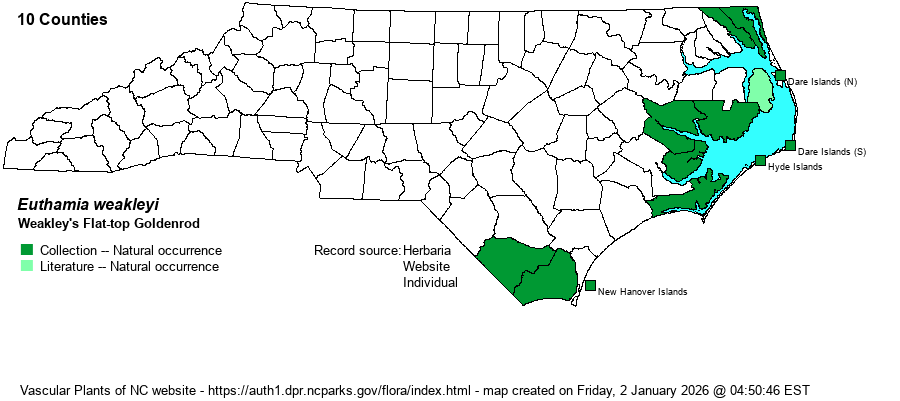| Author | Nesom | |
| Distribution | Scattered on the outer Coastal Plain, barrier islands, and Outer Banks. Nesom (2021a) split out E. hirtipes into two species, the more northerly E. floribunda and the more southerly as E. weakleyi -- see Taxonomic Comments. The counties on the map below are those listed as this taxon in the NCU herbarium. Specimens from other counties near the coast probably lie in other herbaria but have likely not been re-examined.
Coastal Plain, southern NJ to central FL and southwestern AL. | |
| Abundance | Uncommon to locally common, but surprisingly no collections yet from Onslow and Pender counties. The NCNHP treats this taxon on its Watch List, with a State Rank of S2S3; the website editors suggest s rank of S3 is more appropriate. | |
| Habitat | Moist to dry margins of brackish marshes and interdune marshes, interdune swales, maritime woodlands. Generally a species of moist to seasonally wet soils. | |
| Phenology | Flowering and fruiting September-November. | |
| Identification | Our species of flat-top goldenrods can be told from other goldenrods (genus Solidago) by their rather flat-toped inflorescences and by their slender stem leaves that tend to be all about the same size on a given plant. This species grows 1.5-3 feet tall and has leaves with 1-3 (-5) obvious main veins. From E. caroliniana it differs in wider leaves (greater than 3 mm wide vs. less than 2.5 mm wide in that common species) and usually lacks fascicles of small leaves in the axils of stem leaves. The flower heads have many more florets per each head. | |
| Taxonomic Comments | Some authors do not recognize this species, but it has a combination of stable characters that clearly separate it from E. graminifolia and from E. caroliniana. NatureServe only lists it as E. graminifolia var. hirtipes. While the validity of hirtipes as a species is not in question, the taxonomic name is unsettled. In 2021 Nesom monographed the genus in Phytoneuron, in which he treats the mid-Atlantic "hirtipes" as E. floribunda and the more southern hirtipes as E. weakleyi. Weakley (2022) follows Nesom in that treatment. However, Sorrie examined NC specimens of floribunda (including Gates and Hyde counties) and concluded that they fall within the natural variability of E. caroliniana. Specimens of E. weakleyi conform to what BioDiv maintains as E. hirtipes. Note that RAB (1968) named this species (and E. hirtipes) collectively as Solidago tenuifolia.
| |
| Other Common Name(s) | Marsh Flat-top Goldenrod, Weakley's Goldentop | |
| State Rank | S2S3 [S3] | |
| Global Rank | GNR | |
| State Status | W7 | |
| US Status | | |
| USACE-agcp | | |
| USACE-emp | | |

